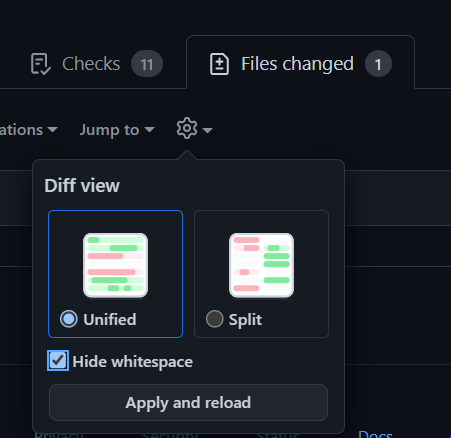review the changes between your old branch and your new one. You can do that
with `git range-diff master @{upstream} HEAD`.
The first argument to `range-diff`, `master` in this case, is the base revision
that you're comparing your old and new branch against. The second argument is
the old version of your branch; in this case, `@upstream` means the version that
you've pushed to GitHub, which is the same as what people will see in your pull
request. Finally, the third argument to `range-diff` is the *new* version of
your branch; in this case, it is `HEAD`, which is the commit that is currently
checked-out in your local repo.
Note that you can also use the equivalent, abbreviated form `git range-diff
master @{u} HEAD`.
Unlike in regular Git diffs, you'll see a `-` or `+` next to another `-` or `+`
in the range-diff output. The marker on the left indicates a change between the
old branch and the new branch, and the marker on the right indicates a change
you've committed. So, you can think of a range-diff as a "diff of diffs" since
it shows you the differences between your old diff and your new diff.
Here's an example of `git range-diff` output (taken from [Git's
docs][range-diff-example-docs]):
```console
-: ------- > 1: 0ddba11 Prepare for the inevitable!
1: c0debee = 2: cab005e Add a helpful message at the start
2: f00dbal ! 3: decafe1 Describe a bug
@@ -1,3 +1,3 @@
Author: A U Thor <author@example.com>
-TODO: Describe a bug
+Describe a bug
@@ -324,5 +324,6
This is expected.
-+What is unexpected is that it will also crash.
++Unexpectedly, it also crashes. This is a bug, and the jury is
++still out there how to fix it best. See ticket #314 for details.
Contact
3: bedead < -: ------- TO-UNDO
```
(Note that `git range-diff` output in your terminal will probably be easier to
read than in this example because it will have colors.)
Another feature of `git range-diff` is that, unlike `git diff`, it will also
diff commit messages. This feature can be useful when amending several commit
messages so you can make sure you changed the right parts.
`git range-diff` is a very useful command, but note that it can take some time
to get used to its output format. You may also find Git's documentation on the
command useful, especially their ["Examples" section][range-diff-example-docs].
## No-Merge Policy
The rust-lang/rust repo uses what is known as a "rebase workflow." This means
that merge commits in PRs are not accepted. As a result, if you are running
`git merge` locally, chances are good that you should be rebasing instead. Of
course, this is not always true; if your merge will just be a fast-forward,
like the merges that `git pull` usually performs, then no merge commit is
created and you have nothing to worry about. Running `git config merge.ff only`
(this will apply the config to the local repo)
once will ensure that all the merges you perform are of this type, so that you
cannot make a mistake.
There are a number of reasons for this decision and like all others, it is a
tradeoff. The main advantage is the generally linear commit history. This
greatly simplifies bisecting and makes the history and commit log much easier
to follow and understand.
## Tips for reviewing
**NOTE**: This section is for *reviewing* PRs, not authoring them.
### Hiding whitespace
Github has a button for disabling whitespace changes that may be useful.
You can also use `git diff -w origin/master` to view changes locally.
